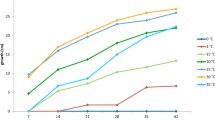Abstract
Coastal ecosystems along the eastern United States are presently threatened by a recurrence of the wasting disease of eelgrass, Zostera marina L. Using Koch's postulates, a species of the marine slime mold, Labyrinthula, is identified as the causal microorganism of this disease. Our disease tests for pathogenicity performed on eelgrass, using four Labyrinthula spp., indicate only one species produces the disease symptoms identical to those found associated with the wasting disease. The pathogenic Labyrinthula sp. has morphological characteristics that distinguish it from the other three species. Identification of Labyrinthula spp. is difficult because species described in the literature are not clearly characterized or identifiable. Tests at various salinities demonstrate that disease symptoms appear infrequently at salinities of 10%. or less.
Similar content being viewed by others
Literature cited
Amon, J. P. (1978). A method for obtaining sporulating Labyrinthula. Mycologia 70: 1297–1299
Armiger, L. C. (1964). An occurrence of Labyrinthula in New Zealand Zostera. N. Z. J. Bot. 2: 3–9
Blegvad, H. (1934). An epidemic disease of eel-grass (Zostera marina L.). Dan. biol. Stn. Rep. 39: 1–8
Brock, T. (1961). Milestones in microbiology. Prentice Hall, Englewood Cliffs, New Jersey
Cotton, A. D. (1933). Disappearance of Zostera marina. Nature, Lond 132: 277
den Hartog, C. (1970). The Seagrasses of the world. New Holland Publ. Co., London
den Hartog, C. (1987). Wasting disease and other dynamic phenomena in Zostera beds. Aquat. Bot. 27: 3–14
Dennison, W. C., Alberte, R. S. (1982). Photosynthetic responses of Zostera marina L. (eelgrass) to in situ manipulations of light intensity. Oecologia 55: 137–144
Gagnon, P. S., Vadas, R. L., May, B. (1980). Genetic identity of annual and perennial forms of Zostera marina L. Aquat. Bot 8: 157–162
Johnson, T. W., Sparrow, F. K. (1961). Fungi in oceans and estuaries. J. Cramer, Weinheim
Kester, D. R., Duedall, I. W., Connors, D. N., Pytkowicz, R. M. (1967). Preparation of artificial seawater. Limnol. Oceanogr. 12: 176–178
Lewin, J. (1966). Silicon metabolism in diatoms. V. Germanium dioxide, a specific inhibitor of diatom growth. Phycologia 6: 1–6
McMillan, C. (1982). Isozymes in seagrasses. Aquat. Bot. 14: 231–243
Milne, L. J., Milne, M. J., (1951). The eelgrass catastrophe. Sci. Am. 184: 52–55
Moffitt, J., Cottam, C. (1941). Eelgrass depletion on the Pacific coast and its effect upon black brant. Wildlife Leaflet 206. U.S. Dept. of the Int. Fish and Wildlife Service
Newell, S. Y., Fell, J. W. (1982). Surface sterilization and the active mycoflora of leaves of a seagrass. Bot. mar. 25: 339–346
Olive, L. S. (1975). The Mycetozoans. Academic Press, New York
Perkins, F. O. (1972). The ultrastructure of holdfast, “rhizoids”, and “slime tracks” in thraustochytriaceous fungi and Labyrinthula spp. Arch. Mikrobiol. 84: 95–118
Perkins, F. O., Amon, J. P. (1969). Zoosporulation in Labyrinthula sp.; an electron microscope study. J. Protozool. 16: 235–257
Pokorny, K. S. (1967). Labyrinthula. J. Protozool. 14: 697–708
Porter, D. (1972). Cell division in the marine slime mold Labyrinthula sp., and the role of the bothrosome in extracellular membrane production. Protoplasma 74: 427–448
Porter, D. (1987). Labyrinthula vitellina. In: Fuller, M. S., Jaworski, A. (eds.) Zoosporic fungi in teaching and research. Southeastern Publishing Co., Athens, Georgia
Porter, D. (1988). Labyrinthulomycota. In: Margulis, L., Corliss, J., Melkonian, M., Chapman, D., (eds.) Handbook of protoctista. Jones and Barnett, Boston (in press)
Rasmussen, E. (1977). The wasting disease of eelgrass (Zostera marina) and its effects on environmental factors and fauna. In: McRoy, C. P., Helfferich, C. (eds.) Seagrass ecosystems: A scientific perspective. Marcel Dekker, New York. p. 1–52
Renn, C. E. (1934). Wasting disease of Zostera in American waters. Nature, Lond. 134: 4516
Renn, C. E. (1935). A mycetozoan parasite of Zostera marina. Nature, Lond. 135: 544–545
Renn, C. E. (1936). Wasting disease of Zostera marine L. A phytological investigation of the diseased plant. Biol. Bull. 70: 148–158
Renn, C. E. (1942). Demonstration of Labyrinthula parasite in eelgrass from the coast of California. Science, New York 95: 122
Short, F. T., Ibelings, B. W., den Hartog, C. (1988). Comparison of a current eelgrass disease to the wasting disease in the 1930s. Aquat. Bot. (in press)
Short, F. T., Mathieson, A. C., Nelson, J. I. (1986). Reccurrence of the eelgrass wasting disease at the border of New Hampshire and Maine, USA. Mar. Ecol. Prog. Ser. 29: 89–92
Short, F. T., Muehlstein, L. K., Porter, D. (1987). Eelgrass Wasting disease: Cause and recurrence of a marine epidemic. Biol. Bull. 173: 557–562
Sykes, E. E., Porter, D. (1973). Nutritional studies of Labyrinthula sp. Mycologia 65: 1302–1311
Young, E. L. (1937). Notes on the Labyrinthulan parasite of the eelgrass Zostera marina. Bull. Mt. Desert Isl. Biol. Lab. pp. 33–35.
Young, E. L. (1938). Labyrinthula on Pacific coast eelgrass. Can. J. Res., sec C, 16: 115–117
Young, E. L. (1943). Studies on Labyrinthula, the etiologic agent of the wasting disease of eel-grass. Amer. J. Bot. 30: 586–593
Watson, S. W. (1951). Studies on Labyrinthula. Techn. Rep. No. 3. Office of Naval Research. University of Washington Oceanographic Laboratories, Seattle, Washington
Watson, S. W. (1957). Cultural and cytological studies on species of Labyrinthula. Ph. D. thesis, University of Wisconsin, Madison
Author information
Authors and Affiliations
Additional information
Communicated by J. P. Grassel, Woods Hole
Rights and permissions
About this article
Cite this article
Muehlstein, L.K., Porter, D. & Short, F.T. Labyrinthula sp., a marine slime mold producing the symptoms of wasting disease in eelgrass, Zostera marina . Mar. Biol. 99, 465–472 (1988). https://doi.org/10.1007/BF00392553
Accepted:
Issue Date:
DOI: https://doi.org/10.1007/BF00392553




